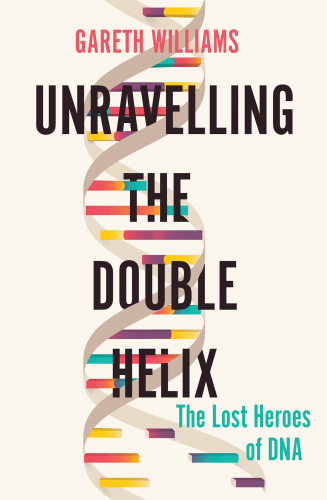
Unravelling the Double Helix
کتاب های مرتبط
- اطلاعات
- نقد و بررسی
- دیدگاه کاربران
نقد و بررسی

July 22, 2019
With this history of how DNA’s role in cellular reproduction and inheritance was uncovered, Williams, emeritus professor of medicine at the University of Bristol, capably conveys the process of how scientific discoveries are made in general, including the false trails, dead ends, and recalcitrant colleagues along the way. He begins his story in 1868, relating how German physician Friedrich Miescher discovered “nuclein,” later renamed DNA, and shows the halting steps scientists took before conclusively determining in 1944 that the substance was central to the transmission of inherited characteristics. He also demonstrates how some, like American biochemist Alfred Mirsky, fought the idea that a molecule as simple as DNA could possibly be responsible for so complex an activity. Along the way, Williams relates how 19th-century Mendelian genetics were merged with 20th century advances in biochemistry, and concludes by recapping the race to discover the three-dimensional structure of DNA. His contention that British scientist Maurice Wilkins, who shared the 1962 Nobel Prize for the discovery with James Watson and Francis Crick, treated his colleague Rosalind Franklin far more fairly than is usually portrayed, will be received with interest, if not necessarily agreement, by genetics buffs. For them, and popular science readers in general, this is a history well worth perusing.

August 1, 2019
A fine history of the first 85 years of DNA and the "stories of the people who became entangled with it and who were variously enthralled, seduced or infuriated." Most readers have heard of James Watson and Francis Crick, but their 1953 discovery of the structure of DNA followed almost a century of biological research. Williams (Emeritus, Medicine/Univ. of Bristol; A Monstrous Commotion: The Mysteries of Loch Ness, 2016, etc.) begins by noting the significant work of 19th-century Swiss physicist Friedrich Miescher that laid the foundation. Although his isolation of nuclein (nucleic acids) was significant, no one realized that it was earth-shaking. Living cells teem with proteins, which are complex molecules. At this time, no one knew how heredity worked. Gregor Mendel's basic rules of genetics, announced in the 1860s, remained unnoticed. It wasn't until 1875 that German biologist Oscar Hertwig first saw a single sperm penetrate an egg and fuse with the nucleus, which then began to divide. Brilliant, obsessive men (and the occasional woman) march through the narrative. Genes and chromosomes make their appearances after 1900. Then X-ray crystallography, the key to deciphering atomic structure, explodes onto the scene. In the 1930s, studies hinting that DNA figured in heredity made little impression. In 1944, proof from Oswald Avery's lab did not achieve iconic status for another decade, when others confirmed it and Watson and Crick worked their magic. Williams' steady stream of biographies includes plenty of key figures unknown, he admits, even to him. They made significant discoveries (or barely missed) that helped to clarify the mechanism of heredity. There is no shortage of villains, tragedies, and missed opportunities, but readers will take comfort in knowing that it turns out well. They will enjoy lucid, opinionated writing and the useful (often neglected) who's who and timeline at the beginning and generous glossary at the end. A superb chronicle of a scientific struggle with a happy ending.
COPYRIGHT(2019) Kirkus Reviews, ALL RIGHTS RESERVED.

October 15, 2019
Deoxyribonucleic acid (DNA), a self-replicating molecule that carries genetic information, is well-known to students and adults alike. Almost as famous are the two scientists, James Watson and Francis Crick, credited for elucidating DNA's structure. Less familiar are the many other researchers whose work made the discovery possible, including Maurice Wilkins, who shared the Nobel Prize with Watson and Crick; Rosalind Franklin; and John Randall, among others. Williams scrutinizes the 85-year period of scientific inquiry that culminated with Watson and Crick creating the model for DNA in 1953, explaining the biochemistry and X-ray crystallography technology behind the breakthrough. But this story of DNA is primarily told through its "cast members." In brief biographies of the many people enmeshed in and often obsessed with investigating DNA over decades, Williams highlights the challenges, personalities, and motives of researchers. "Science can be a messy business," he writes. Indeed, while some of the researchers depicted are valiant and bold, others behave badly. In all, Williams has forged a vibrant portrayal of the numerous scientists searching for the structure of biology's most powerful and elegant molecule.(Reprinted with permission of Booklist, copyright 2019, American Library Association.)

























دیدگاه کاربران